
The Duchy of Lorraine, originally Upper Lorraine, was a duchy now included in the larger present-day region of Lorraine in northeastern France. Its capital was Nancy.

Stanisław I Leszczyński, also Anglicized and Latinized as Stanislaus I, was twice King of Poland and Grand Duke of Lithuania, and at various times Prince of Deux-Ponts, Duke of Bar and Duke of Lorraine.
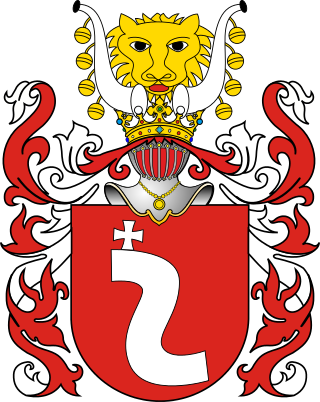
Srzeniawa is a Polish coat of arms. It was used by several szlachta families in the times of the Kingdom of Poland and the Polish–Lithuanian Commonwealth.

Wieniawa is a Polish coat of arms. It was used by several noble, in Polish language szlachta families in the times of medieval Poland and the Polish–Lithuanian Commonwealth.
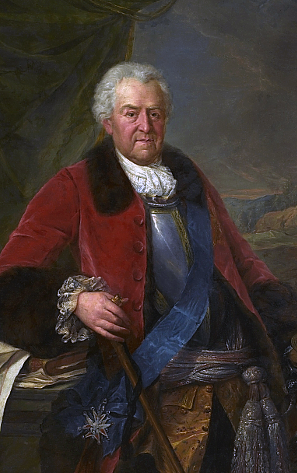
Stanisław Poniatowski was a Polish military commander, diplomat, and noble. Throughout his career, Poniatowski served in various military offices, and was a general in both the Swedish and Polish–Lithuanian militaries. He also held numerous civil positions, including those of podstoli of Lithuania and Grand Treasurer of the Lithuanian army in 1722, voivode of the Masovian Voivodeship in 1731, regimentarz of the Crown Army in 1728, and castellan of Kraków in 1752. Throughout his lifetime, he served in many starost positions.

The Brześć Kujawski Voivodeship was a unit of administrative division and local government in the Kingdom of Poland, from the 14th century to the Second Partition of Poland in 1793. It was part of the historic Kuyavia region and the Greater Poland Province. Originally, its name was Brzesc Voivodeship, but after the 1569 Union of Lublin, it was renamed into Brześć Kujawski Voivodeship, to distinguish it from Lithuanian Brest Litovsk Voivodeship.

The coat of arms of the Polish–Lithuanian Commonwealth was the symbol of the Polish–Lithuanian Commonwealth, representing the union of the Crown of the Polish Kingdom and Grand Duchy of Lithuania.

The House of Leszczyński was a prominent Polish noble family. They were magnates in the Polish–Lithuanian Commonwealth and later became royal family of Poland.
Rafał Leszczyński was a Polish–Lithuanian noble and Imperial count. He was the castellan of Kalisz starting in 1618, he became the voivode of Bełz in 1620, and the starost of Hrubieszów in 1633. He was extensively educated in law, humanities, theology, military science, natural sciences, and even studied under Galileo. He also traveled over much of Europe.

Józef Andrzej Załuski was a Polish Catholic priest, Bishop of Kiev, a sponsor of learning and culture, and a renowned bibliophile. A member of the Polish nobility (szlachta), bearing the hereditary Junosza coat-of-arms, he is most famous as co-founder of the Załuski Library, one of the largest 18th-century book collections in the world.

Countess Catherine Opalińska, was by birth member of House of Opaliński, Queen consort of the Polish–Lithuanian Commonwealth twice and Duchess consort of Lorraine through her marriage with Stanisław I of Poland.

The Treaty of the Three Black Eagles, or Treaty of Berlin, was a secret treaty signed in September and December 1732 between the Habsburg monarchy, the Russian Empire and Prussia.
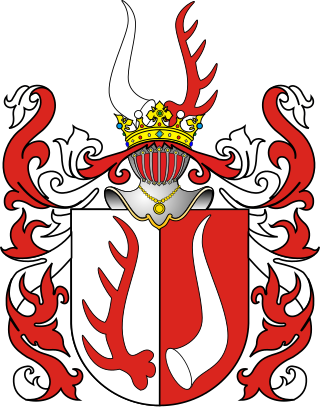
Rogala is a Polish coat of arms, likely imported from Germany to Poland in 1109 by the Rogala or the Ribersztein family, that then added the second horn. It was used by several szlachta families in the times of the Polish–Lithuanian Commonwealth.
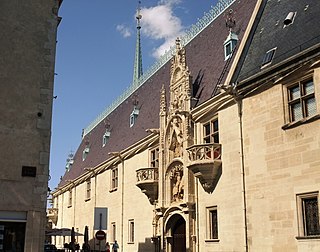
The Ducal Palace of Nancy is a former princely residence in Nancy, France, which was home to the Dukes of Lorraine. It houses the Musée Lorrain, one of Nancy's principal museums, dedicated to the art, history and popular traditions of Lorraine until the early 20th century. It has been listed since 1840 as a monument historique by the French Ministry of Culture.

Stanisław Kostka Gadomski de Rola (1718–1797) was a Polish nobleman and governor of the Łęczyca Province of Poland since 1787. He was also the Speaker of the Sejm, General officer of the Armed Forces in the Polish–Lithuanian Commonwealth and Starost of Krystynopol.
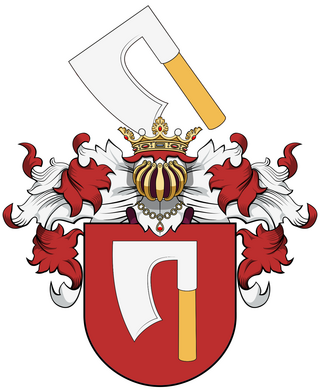
Hieronim Ossoliński,, coat of arms Topór, was a Polish statesman, kasztelan of Sandomierz and Wojnicz, a delegate to the Sejm of 1569 and one of the signatories of the Union of Lublin, which formally united Poland and Lithuania into the Polish–Lithuanian Commonwealth. Ossoliński was a Calvinist, and a leader of Protestants in the province of Małopolska during the reign of king Zygmunt August. Ossoliński was also one of the leaders of the Executionist movement, which sought to reform 16th century Polish politics.

The Bibliothèque municipale de Nancy is a public library in Nancy, France. It houses approximately 400,000 documents, books, maps, plans and prints. Polish king Stanisław Leszczyński began the collection in 1750. The library is located in a 1769 building of the historical University of Nancy. At 43, rue Stanislas, it is close to the Place Stanislas and the Gare de Nancy-Ville.

The House of Mielżyński is the name of one of Poland's oldest noble families. They used the Nowina coat of arms.
Głos wolny wolność ubezpieczający is a Polish political treatise. It was written some time between 1733 and 1743, and published in 1743 in Nancy by former king of Poland Stanisław Leszczyński. While Leszczyński himself claimed authorship, some modern scientists believe it was rather ghostwritten by someone of his retinue, possibly Mateusz Białłozor. One of the most important political works of Enlightenment in Poland, it is possible that the French translation of the work, La Voie Libre, influenced Jean Jacques Rousseau.

The Basilique Notre Dame du Bon Secours, Marie Auxiliatrice is a Roman Catholic minor basilica in Bonsecours near Rouen, Seine—Maritime, France. It is the first church in France to be built in the Gothic Revival style. The basilica is highly ornately decorated with windows, sculptures and other elements often carrying the name or coat of arms of a patronal donor.




















